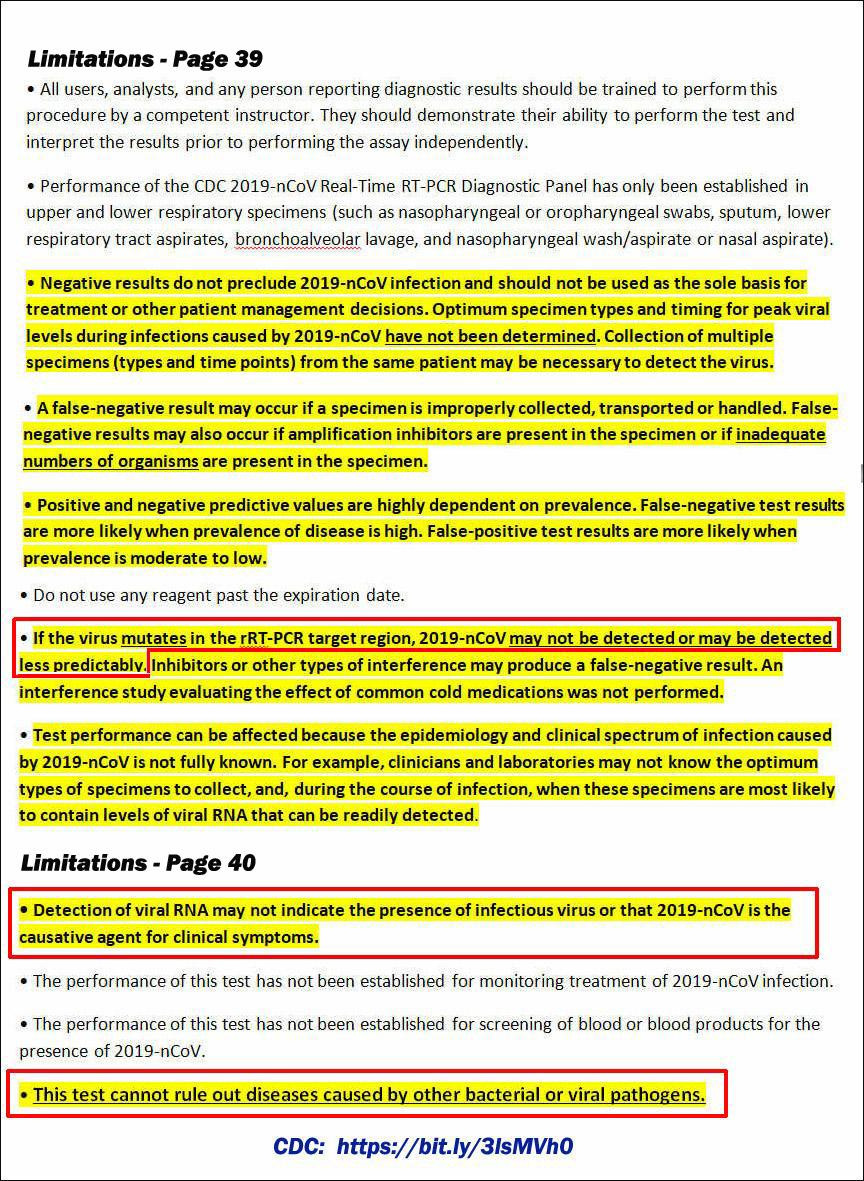CDC Document Confirms PCR has no value at detecting Covid-19 infection
CDC Admits the PCR Test Will Test Positive with Cold of Flu Virus "
The highlighted limitations below are evidence that the CDC is fully aware that PCR is not capable of diagnosing an infectious coronavirus.
CDC Document dated 07/13/2020
CDC 2019-Novel Coronavirus (2019-nCoV) Real-Time RT-PCR Diagnostic Panel
CDC-006-00019, Revision: 05 CDC/DDID/NCIRD/ Division of Viral Diseases Effective: 07/13/2020
Document Link PDF: http://www.fda.gov/media/134922/download
CDC Document dated 07/13/2020
CDC 2019-Novel Coronavirus (2019-nCoV) Real-Time RT-PCR Diagnostic Panel
CDC-006-00019, Revision: 05 CDC/DDID/NCIRD/ Division of Viral Diseases Effective: 07/13/2020
Document Link PDF: http://www.fda.gov/media/134922/download
Limitations Page 39
- All users, analysts, and any person reporting diagnostic results should be trained to perform this procedure by a competent instructor. They should demonstrate their ability to perform the test and interpret the results prior to performing the assay independently.
- Performance of the CDC 2019-nCoV Real-Time RT-PCR Diagnostic Panel has only been established in upper and lower respiratory specimens (such as nasopharyngeal or oropharyngeal swabs, sputum, lower respiratory tract aspirates, bronchoalveolar lavage, and nasopharyngeal wash/aspirate or nasal aspirate).
- Negative results do not preclude 2019-nCoV infection and should not be used as the sole basis for treatment or other patient management decisions. Optimum specimen types and timing for peak viral levels during infections caused by 2019-nCoV have not been determined. Collection of multiple specimens (types and time points) from the same patient may be necessary to detect the virus.
- A false-negative result may occur if a specimen is improperly collected, transported or handled. False-negative results may also occur if amplification inhibitors are present in the specimen or if inadequate numbers of organisms are present in the specimen.
- Positive and negative predictive values are highly dependent on prevalence. False-negative test results are more likely when prevalence of disease is high. False-positive test results are more likely when prevalence is moderate to low.
- Do not use any reagent past the expiration date.
- If the virus mutates in the rRT-PCR target region, 2019-nCoV may not be detected or may be detected less predictably. Inhibitors or other types of interference may produce a false-negative result. An interference study evaluating the effect of common cold medications was not performed.
- Test performance can be affected because the epidemiology and clinical spectrum of infection caused by 2019-nCoV is not fully known. For example, clinicians and laboratories may not know the optimum types of specimens to collect, and, during the course of infection, when these specimens are most likely to contain levels of viral RNA that can be readily detected.
Limitations Page 40
- Detection of viral RNA may not indicate the presence of infectious virus or that 2019-nCoV is the causative agent for clinical symptoms.
- The performance of this test has not been established for monitoring treatment of 2019-nCoV infection.
- The performance of this test has not been established for screening of blood or blood products for the presence of 2019-nCoV.
- This test cannot rule out diseases caused by other bacterial or viral pathogens.
Permalink - https://bit.ly/37A3tOs

